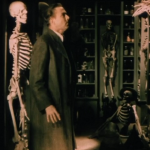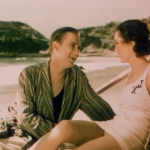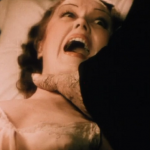 |
 |
 |
| Lee Taylor … Lee Tracy |
Joanne Xavier … Fay Wray |
Dr. Xavier … Lionel Atwill |
Proof That It’s Pre-Code
- One of the film’s scientists is seen reading a book studiously, though one of the nearby cops points out that he’s really reading a magazine called “French Art” hidden inside the book.
- The movie’s about a serial killer who eats his victims. Cannibalism was considered grotesque under the code, and usually shied away from.
- Also, our intrepid reporter has to call in a story inside the brothel, and gets distracted several times looking at the merchandise.
- There’s a decent amount of fairly gruesome images.

“Mmm, this corpse is yummy! Let me just add some salt…”
Doctor X: Doctors Demented
“Something tells me if I go in that room tonight, tomorrow I’ll be in my coffin!”
So about 12 years ago I was in Columbia, Missouri, and working at one of the student newspapers as a feature writer. Halloween rolled around and I took my girlfriend– a photographer for the paper– to a charity haunted house put on by a local fraternity. We got an early preview, meaning that not only were we in a haunted house, we were the only two guests in that entire haunted house.
As you can imagine, they felt the need to pull out all of the stops. Part of the attraction was a winding trail behind the house you could see shacks and other dangers lurking ahead. After a few brushes with cackling mad scientists and a few too many strobe lights illuminating dripping blood, we spent the moments between the stations frantically pushing the other person in front. We knew that, while we both loved and cared about each other deeply, the other person would probably have a richer experience if they were to be the first to meet the man in a jumpsuit carrying a chainsaw.
This kind of giddy sense of terror is one that comes out in Doctor X, a mix of several 30s genres to great success. The film’s comedy is very much in the vein of the later Abbott and Costello meet the Universal Monsters films, with the hero completely out of his element and jumping at every creaking floorboard. However, unlike Costello, hero Lee Taylor’s own journalistic sense of nobility kicks in, allowing him to alternate between being a noble reporter and a terrified schmuck. I can’t blame him for either reaction.

“Hahaha. I die at the end, don’t I?”
That’s because he’s on the trail of a murderer known as the Moon Killer. The police have called in Doctor Xavier, a local and well known psychologist to investigate his latest killing: a scrub woman on the street. Every murder occurs under the full moon, and each victim shows marks that chunks of the victim may have been eaten.
The cops have an ulterior motive to Xavier’s presence, and that’s because they believe that one of the research scientists working beneath him may be the murderer. He has a hardy group of men with all sorts of morbid history; one is a castaway survivor whose shipmate mysteriously disappeared, another studies the effect of moon rays on peoples’ minds and seems a little too into it, one is disabled but sure can walk fine when he needs to, and one has even written an entire book on cannibalism. Add in that Dr. Xavier has been feeling tired lately and acting strange, and it’s not hard to imagine that his research laboratory was staffed in hopes of creating perhaps the most suspicious group of people ever.
Xavier convinces the police to give him 48 hours to uncover the murderer himself using a convoluted scientific process that requires reenacting the murders and measuring the excitement present in the other scientists. Since the art deco labs with their sharp lines and copious lighting are a little too formal, he adjourns with the scientists to his creepy secret-passage filled mansion on the cliffs of Long Island. I mean, there he has a room that is just filled with skeletons, and he can’t let that go to waste.
Xavier also brings his daughter, Joanne, and his servants, one of who I’m certain was named Igor. Intrepid reporter Taylor trails close behind.

“Oh, yeah, all of the candles make me feel right at home here.”
Shenanigans abound. Taylor is hit with some knockout gas while eavesdropping. One of the scientists is murdered during the first experiment when the lights go out. Shadowy figures watch Joanne while she lays at the beach. And a hideous monster keeps lurking in the shadows…
Despite Doctor Xavier’s house of intricate scientific tomfoolery, in the end it’s good old fashioned quick thinking that saves the day. Taylor’s final fight with the monster, which includes a pitch that he learned from his youth, is the final blow to the film’s anti-scientific slant, where everyone’s dedication to study and learning blinds them to the effects that their rigorous methods will yield. Case in point: when you lock everyone in handcuffs and leave your beautiful daughter on a gurney, maybe you should be a bit more cautious in regards to the man with the only set of keys.
The film’s a comedy for most of its running time, but that melts away for the most part as the last act reveals the criminal mastermind. We’re treated to a lengthy sequence showing how the villain transforms himself by means of ‘synthetic flesh’, which he hauntingly repeats as he rubs goo over his face. Director Michael Curtiz delves into dreamlike imagery for this sequence, and lets the killer’s body modification glow in unearthly oranges and with horrifying delight. The sequence has been called ‘Cronnenberg-esque’ by many, and its hard to deny that the film sees scientific attempts to modify and supplement the body as the path to a new, grotesque species of madmen.

THAT’S NOT HOW GRAVY WORKS
Don’t be fooled, though, for about 60 minutes of the film’s 77 minute run time, this film is a rather dark tinged comedy. Lee Tracy’s pratfalls, double takes, and backbiting witticisms are on full display. However, there’s one thing that really endears me to this, that I haven’t seen in a lot of other Lee Tracy films I’ve checked out: his character of Taylor frequently gets unnerved and embarrassed.


And on that latter point, well, Fay Wray as the female romantic lead isn’t given any sort of courageous features, though, honestly, in her situation during the climax, I would have been too terrified to move an inch as well. Wray’s Joanne has a very serious Electra complex, idolizing her father and worrying about him constantly. That Taylor is able to wedge himself in there at the very end by sheer bravado is another point for the film’s faith in the common man over the scientist whose plans did nothing but get people killed.
Doctor X’s unique look comes by way of two-strip Technicolor, a process that uses reds and greens to define images. Since it’s lacking other colors from its pallet, the movie takes on an unearthly tone, enhancing the film’s slightly surreal mood. It works to great effect as Curtiz still uses techniques to enhance shadows, but also splits the colors so that they can emphasize one piece of the frame over another. Though not as sharp as black and white, the look is undeniably haunting.

Not dead yet!
Doctor X is a nice haunted house attraction, even if it isn’t as deep or moody as the movies Universal was pumping out around the same time. The film’s great look and good performances make this a surreal but fun murder mystery.
Gallery
Here are some extra screenshots I took. Click on any picture to enlarge!
Trivia & Links
- There’s a 1939 film called The Return of Doctor X starring non other than Humphrey Bogart. Despite the title, though, the two films are unrelated. You can read an appraisal of it from Cinematic Catharsis.
- Reading a couple of different sources, it sounds like the film was made in color because Warner Brothers had a combination of Technicolor film stock laying around and a contractual obligation to make the films. In the early talkies, usually musicals had either the entire thing or certain sequences filmed in color. Besides the demise of the musical after the disastrous 1930 film year, the color sequences also didn’t do much in making the numbers seem any more special. As you can tell from the screenshots, two-strip Technicolor is pretty muddy, and it took a well-trained eye to make it look any good. The only other horror movie from this time made at Warner’s with this technique was also by Michael Curtiz and made shortly after this one: The Mystery of the Wax Museum.
- If you think the film’s mansion looks familiar to you, its sets popped up again in Miss Pinkerton.

“Find me Joan Blondell, ASAP!”
- As evidenced in one of the pages below, this film came out the same month as Tracy’s turn in Blessed Event, in which he also played a newspaper reporter.
- This film was originally filmed simultaneously in color and in black and white, and supposedly the two versions used different takes in several scenes. The color version was considered lost until 1973 before it was rediscovered and restored by UCLA. Now, of course, the black and white version is much more obscure.
- Nate Yapp at Classic-Horror.Com has this excellent observation about how the film inverted classic tropes of the ‘Old Dark House’ genre that was popular around that time:
In your normal old dark house flick, a group of people gathers at some remote, sinister mansion or castle. Some force which can only be supernatural stalks and/or kills them, but the culprit is revealed to be perfectly human before the end credits roll. The cartoon series “Scooby-Doo, Where Are You?” would later appropriate the format for its own, more comical purposes. In Doctor X, a group of people gather in a remote, sinister mansion, but they assume that the force that stalks them must be completely natural — after all, this is the real world. It is only at the end that the killer is revealed to be something more bizarre than just human.

“Roinks!”
- Mordaunt Hall at the New York Times was blown away by this one. He notes, “It is a production that almost makes “Frankenstein” seem tame and friendly, particularly in its penultimate glimpses.”
- Not Coming to a Theater Near You talks about the film’s origins and includes an excerpt from the film’s screenplay describing the grotesque monster.
- Greenbriar Picture Show stages an appreciation for the film’s set designer Anton Grot with a lot of gorgeous behind-the-scenes pictures.

You’d be hard pressed to say that this film isn’t unique looking.
- TCMDB has its usual range of trivia.
- Lots of posters for this over at Dr. Macro; can’t say I’m a huge fan of any of them.
- I’ve found myself really enjoying the reviews from The Stranger, and their take on the film’s color pallet really struck me as hitting the nail right on the head:
What really gives the film (produced independently but distributed by Warner) its unique tarnish is an early, two-strip Technicolor process, which envelops the action in a sea of queasy algae-green, as if the universe around the narrative’s secret ritual was stagnant and rotting.
Primary Sources
Thanks to Lantern, there are hundreds of issues of fan magazine and industry journals from the pre-Code era available for free. Here are some related articles; click on the ‘View Full Sized Image’ in the bottom right to view!
Awards, Accolades & Availability
- This film appeared in the Wikipedia List of Pre-Code Films.
- This film is available on Amazon and is currently streaming on Warner Instant.
 |
Comment below or join our email subscription list on the sidebar!Home | All of Our Reviews | What is Pre-Code? |












































9 Comments
Caren · October 11, 2013 at 3:15 pm
I viewed this film several months ago mainly because I was interested in the two-strip Technicolor. Yes, it was lots of fun. And, because pre-Code is also a favourite of mine, I thought the most quirky scene to illustrate this was when Lee Tracy uses the phone at a nearby brothel. Thanks for the lovely review Danny.
Danny · October 11, 2013 at 4:56 pm
My pleasure, Caren. Glad you’re still checking out good stuff!
brianpaige · October 11, 2013 at 3:50 pm
Doctor X rules, rules, rules. I first saw the movie in about 1991 and the finale stayed with me for weeks. At first I kind of thought Tracy sucked but on repeat viewings his performance oddly grows on you. It isn’t really prime Tracy though (for that you need stuff like Blessed Event, The Half Naked Truth, or The Nuisance). He really is the lead here despite only getting 3rd billing behind Atwill and Wray. If you think about it, his role is incredibly difficult to pull off in that he’s some combo of terrified comedy relief reporter, action hero, and romantic lead. Who else could do all of that?
One of the best horror movies of the 30s in my opinion. It doesn’t have anything ultra special on its mind, but for entertainment it is awesome.
Danny · October 11, 2013 at 4:59 pm
Exactly! Tracy is great here, really selling a character who would seem schizophrenic to most. And that ending… you spend most of the movie in a comfortable groove and it just pulls the rug out from under you. Great stuff.
Joe Kenney · January 20, 2015 at 1:35 am
Hello,
I recently discovered your blog, and really enjoy it. Just a quick initial note — for Dr. X, the color is altered on the DVD release (and TCM showings). Since it was 3-strip Technicolor, there should be no blue in the film, however you can see it everywhere, particularly on Fay Wray’s dress, which should be green. Same for the Wax Museum DVD. I’ve read though that the old laserdisc releases for these two films contain the original 3-strip print. This has been confirmed by the diehards who’ve seen original prints in theater showings. We’re not talking about lifechanging differences here, but it would be interesting to see.
You can read more here: http://monsterkidclassichorrorforum.yuku.com/topic/1169/quotDR-Xquot-and-the-color-of-money?page=1#.VL0yQCvF-VM
Danny · January 21, 2015 at 8:37 pm
Thanks for the info!
Vic · July 10, 2016 at 5:37 am
This film wasn’t shooting in Three strip color but in two strip tecnicolor (red-green).
Comments are closed.